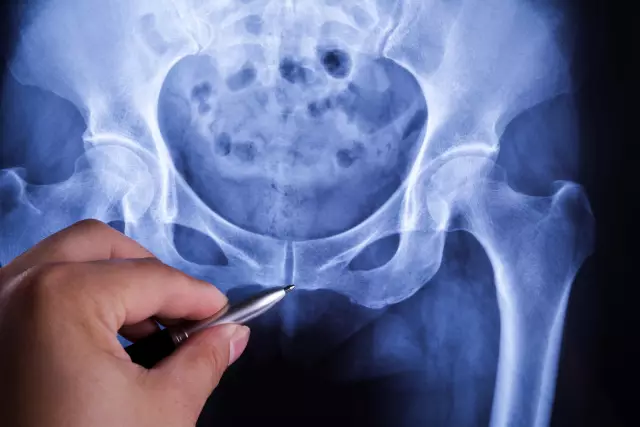- Author Rachel Wainwright [email protected].
- Public 2023-12-15 07:39.
- Last modified 2025-11-02 20:14.
Tibia
The tibia is a large and long bone of the lower leg. The bone consists of a body and two epiphyses - the lower distal and upper proximal.

The structure of the tibia
The body of the bone has a triangular shape with three edges - anterior, medial and interosseous, and three surfaces - medial, posterior and lateral.
The anterior edge of the bone has a pointed shape and resembles a ridge in appearance. In the upper part, it becomes tuberosity. The interosseous margin has a pointed shape and a scallop appearance. This comb is directed towards the fibula. The medial surface of the bone is slightly convex and is easily felt through the skin along with the anterior edge of the tibial body.
The lateral (antero-outer) surface of the bone is slightly concave. And the back surface is flat. On the posterior surface is the soleus muscle line, which extends from the lateral condyle medially and downward. Slightly below the feeding hole is located, which extends into the distally directed feeding channel.
The proximal epiphysis of the tibia is slightly widened. Its lateral parts are the lateral and medial condyles. Outside the lateral condyle there is a flat peroneal articular surface. At the top of the proximal pineal gland in the middle section is the intercondylar eminence, in which two tubercles can be distinguished:
- internal medial intercondylar, behind which the posterior intercondylar field can be distinguished;
- the external lateral intercondylar, in front of which is the anterior intercondylar field.
The two margins are the attachment points for the cruciate knee ligaments. On the sides of the intercondylar eminence along the upper articular surface, the articular surfaces, which have a concave shape - medial and lateral, stretch to each condyle. Concave articular surfaces are bounded on the periphery by the edge of the tibia.
The distal epiphysis of the bone has a quadrangular shape. On its lateral surface there is a peroneal notch adjacent to the distal epiphysis of the fibula. The ankle groove runs along the posterior surface of the distal pineal gland. In front of the groove, the medial edge of the distal epiphysis of the tibia passes into the medial malleolus - a downward process that is well palpable. The articular surface of the ankle is located on the lateral surface of the ankle. It passes into the lower surface of the bone and stretches into the lower concave articular surface of the tibia.
Fracture of the tibia
All fractures of the tibia are divided into:
- oblique;
- transverse;
- intra-articular;
- fragmented;
- comminuted.
Intra-articular fractures include fractures of the medial malleolus and tibial condyles. The medial malleolus serves as an internal bone stabilizer for the ankle joint. As a rule, its fracture occurs as a result of twisting the lower leg with a fixed foot. It is also common for an inner ankle fracture to occur as a result of a non-physiological abrupt turn of the foot.
The main symptoms of tibial fractures are:
- The tibia hurts during movement and palpation;
- Due to the displacement of bone fragments, the lower leg is deformed (the axis of the limb changes);
- Edema occurs;
- It is not possible to carry out axial load on the leg.
The treatment of fractures is mainly carried out with the help of surgery. As a rule, the patient can exercise the load on the injured leg the next day after the operation.
Tibia cyst
Quite often, when the shin bone hurts, this may indicate the presence of a cyst.
Bone cyst is a disease during which a thickening forms in the cavity of the bone tissue.
Until now, the exact origin of bone cysts has not been clarified. It has been established that tibia cysts appear as a result of hemodynamic disorders in a limited area of the bone. In fact, the formation of a cyst is a dystrophic process. The formation of cysts is based on the violation of intraosseous blood circulation and the activation of lysosomal enzymes, leading to the destruction of collagen, glucosaminoglycans and other proteins. According to the international classification, cysts are referred to as tumor-like diseases.
Bone cyst can be solitary and aneurysmal. A solitary cyst develops over a long period of time, it is more common in adolescence in males. An aneurysmal cyst occurs suddenly and develops rapidly. Most often, an aneurysmal cyst results from direct injury to the bone.
Despite the general nature of these diseases, it is customary to clearly distinguish between them, since they have different symptoms and radiological pictures.
Found a mistake in the text? Select it and press Ctrl + Enter.






